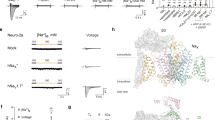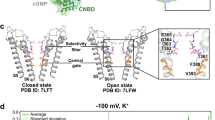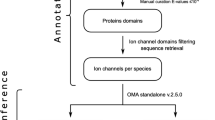Abstract
NaChBac is a bacterial voltage-gated sodium (Nav) channel that shows sequence similarity to voltage-gated calcium channels. To understand the ion-permeation mechanism of Nav channels, we combined molecular dynamics simulation, structural biology and electrophysiological approaches to investigate the recently determined structure of NavRh, a marine bacterial NaChBac ortholog. Two Na+ binding sites are identified in the selectivity filter (SF) in our simulations: The extracellular Na+ ion first approaches site 1 constituted by the side groups of Ser181 and Glu183, and then spontaneously arrives at the energetically more favorable site 2 formed by the carbonyl oxygens of Leu179 and Thr178. In contrast, Ca2+ ions are prone to being trapped by Glu183 at site 1, which then blocks the entrance of both Na+ and Ca2+ to the vestibule of the SF. In addition, Na+ permeates through the selective filter in an asymmetrical manner, a feature that resembles that of the mammalian Nav orthologs. The study reported here provides insights into the mechanism of ion selectivity on Na+ over Ca2+ in mammalian Nav channels.
Similar content being viewed by others
Log in or create a free account to read this content
Gain free access to this article, as well as selected content from this journal and more on nature.com
or
References
Hodgkin AL, Huxley AF . Resting and action potentials in single nerve fibres. J Physiol 1945; 104:176–195.
Hille B . Ion Channels of Excitable Membranes. 3rd Edition. Sunderland, MA: Sinauer Associates, 2001.
Guy HR, Seetharamulu P . Molecular model of the action potential sodium channel. Proc Natl Acad Sci USA 1986; 83:508–512.
Jiang YX, Lee A, Chen JY, et al. X-ray structure of a voltage-dependent K+ channel. Nature 2003; 423:33–41.
Long SB, Campbell EB, Mackinnon R . Crystal structure of a mammalian voltage-dependent Shaker family K+ channel. Science 2005; 309:897–903.
Long SB, Tao X, Campbell EB, MacKinnon R . Atomic structure of a voltage-dependent K+ channel in a lipid membrane-like environment. Nature 2007; 450:376–382.
Butterwick JA, MacKinnon R . Solution structure and phospholipid interactions of the isolated voltage-sensor domain from KvAP. J Mol Biol 2010; 403:591–606.
Long SB, Campbell EB, Mackinnon R . Voltage sensor of Kv1.2:structural basis of electromechanical coupling. Science 2005; 309:903–908.
Hodgkin AL, Huxley AF . A quantitative description of membrane current and its application to conduction and excitation in nerve. J Physiol 1952; 117:500–544.
Doyle DA, Cabral JM, Pfuetzner RA, et al. The structure of the potassium channel:Molecular basis of K+ conduction and selectivity. Science 1998; 280:69–77.
Zhou YF, Morais-Cabral JH, Kaufman A, MacKinnon R . Chemistry of ion coordination and hydration revealed by a K+ channel-Fab complex at 2.0 angstrom resolution. Nature 2001; 414:43–48.
Nishida M, Cadene M, Chait BT, MacKinnon R . Crystal structure of a Kir3.1-prokaryotic Kir channel chimera. EMBO J 2007; 26:4005–4015.
Tao X, Avalos JL, Chen J, MacKinnon R . Crystal structure of the eukaryotic strong inward-rectifier K(+) channel Kir2.2 at 3.1 angstrom resolution. Science 2009; 326:1668–1674.
Hansen SB, Tao X, MacKinnon R . Structural basis of PIP(2) activation of the classical inward rectifier K(+) channel Kir2.2. Nature 2011; 477:495–498.
Whorton MR, MacKinnon R . Crystal structure of the mammalian GIRK2 K(+) channel and gating regulation by G proteins, PIP(2), and sodium. Cell 2011; 147:199–208.
Brohawn SG, del Marmol J, MacKinnon R . Crystal structure of the human K2P TRAAK, a lipid- and mechano-sensitive K+ ion channel. Science 2012; 335:436–441.
Clayton GM, Altieri S, Heginbotham L, Unger VM, Morais-Cabral JH . Structure of the transmembrane regions of a bacterial cyclic nucleotide-regulated channel. Proc Natl Acad Sci USA 2008; 105:1511–1515.
Hille B . The permeability of the sodium channel to organic cations in myelinated nerve. J Gen Physiol 1971; 58:599–619.
Hille B . The hydration of sodium ions crossing the nerve membrane. Proc Natl Acad Sci USA 1971; 68:280–282.
Corry B, Thomas M . Mechanism of ion permeation and selectivity in a voltage gated sodium channel. J Am Chem Soc 2011; 134:1840–1846.
Furini S, Domene C . On conduction in a bacterial sodium channel. PLoS Comput Biol 2012; 8:e 1002476.
McNulty MM, Edgerton GB, Shah RD, et al. Charge at the lidocaine binding site residue Phe-1759 affects permeation in human cardiac voltage-gated sodium channels. J Physiol 2007; 581:741–755.
Terlau H, Heinemann SH, Stuhmer W, et al. Mapping the site of block by tetrodotoxin and saxitoxin of sodium channel II. FEBS Lett 1991; 293:93–96.
Chiamvimonvat N, Perez-Garcia MT, Ranjan R, Marban E, Tomaselli GF . Depth asymmetries of the pore-lining segments of the Na+ channel revealed by cysteine mutagenesis. Neuron 1996; 16:1037–1047.
Favre I, Moczydlowski E, Schild L . On the structural basis for ionic selectivity among Na+, K+, and Ca2+ in the voltage-gated sodium channel. Biophys J 1996; 71:3110–3125.
Schlief T, Schonherr R, Imoto K, Heinemann SH . Pore properties of rat brain II sodium channels mutated in the selectivity filter domain. Eur Biophys J 1996; 25:75–91.
Sun YM, Favre I, Schild L, Moczydlowski E . On the structural basis for size-selective permeation of organic cations through the voltage-gated sodium channel. Effect of alanine mutations at the DEKA locus on selectivity, inhibition by Ca2+ and H+, and molecular sieving. J Gen Physiol 1997; 110:693–715.
Heinemann SH, Terlau H, Stuhmer W, Imoto K, Numa S . Calcium channel characteristics conferred on the sodium channel by single mutations. Nature 1992; 356:441–443.
Woodhull AM . Ionic blockage of sodium channels in nerve. J Gen Physiol 1973; 61:687–708.
Armstrong CM, Cota G . Calcium ion as a cofactor in Na channel gating. Proc Natl Acad Sci USA 1991; 88:6528–6531.
Armstrong CM, Cota G . Calcium block of Na+ channels and its effect on closing rate. Proc Natl Acad Sci USA 1999; 96:4154–4157.
Zamponi GW, French RJ . Sodium current inhibition by internal calcium:a combination of open-channel block and surface charge screening? J Membr Biol 1995; 147:1–6.
French RJ, Worley JF, Wonderlin WF, Kularatna AS, Krueger BK . Ion permeation, divalent ion block, and chemical modification of single sodium channels. Description by single- and double-occupancy rate-theory models. J Gen Physiol 1994; 103:447–470.
Ren D, Navarro B, Xu H, et al. A prokaryotic voltage-gated sodium channel. Science 2001; 294:2372–2375.
Yue L, Navarro B, Ren D, Ramos A, Clapham DE . The cation selectivity filter of the bacterial sodium channel, NaChBac. J Gen Physiol 2002; 120:845–853.
Payandeh J, Scheuer T, Zheng N, Catterall WA . The crystal structure of a voltage-gated sodium channel. Nature 2011; 475:353–358.
Zhang X, Ren W, DeCaen P, et al. Crystal structure of an orthologue of the NaChBac voltage-gated sodium channel. Nature 2012; 486:130–134.
Carnevale V, Treptow W, Klein ML . Sodium ion binding sites and hydration in the lumen of a bacterial ion channel from molecular dynamics simulations. J Phys Chem Lett 2011; 2:2504–2508.
Qiu H, Shen R, Guo W . Ion solvation and structural stability in a sodium channel investigated by molecular dynamics calculations. Biochim Biophys Acta 2012; 1818:2529–2535.
Dudev T, Lim C . Factors governing the Na+ vs K+ selectivity in sodium ion channels. J Am Chem Soc 2010; 132:2321–2332.
Dudev T, Lim C . Why voltage-gated Ca2+ and bacterial Na+ channels with the same EEEE motif in their selectivity filters confer opposite metal selectivity. Phys Chem Chem Phys 2012; 14:12451–12456.
Darve E, Pohorille A . Calculating free energies using average force. J Chem Phys 2001; 115:9169–9183.
Darve E, Rodriguez-Gomez D, Pohorille A . Adaptive biasing force method for scalar and vector free energy calculations. J Chem Phys 2008; 128: 144120.
Darve E, Wilson M, Pohorille A . Calculating free energies using a scaled-force molecular dynamics algorithm. Mol Simulat 2002; 28:113–144.
Rodriguez-Gomez D, Darve E, Pohorille A . Assessing the efficiency of free energy calculation methods. J Chem Phys 2004; 120:3563–3578.
Zwanzig RW . High-temperature equation of state by a perturbation method. II. Polar gases. J Chem Phys 1955; 23:1915–1922.
Kollman P . Free energy calculations: applications to chemical and biochemical phenomena. Chem Rev 1993; 93:2395–2417.
Hodgkin AL, Keynes RD . The potassium permeability of a giant nerve fibre. J Physiol 1955; 128:61–88.
Illingworth CJ, Domene C . Many-body effects and simulations of potassium channels. Proc R Soc A Mathem Phys Eng Sci 2009; 465:1701–1716.
Phillips JC, Braun R, Wang W, et al. Scalable molecular dynamics with NAMD. J Comput Chem 2005; 26:1781–1802.
MacKerell AD Jr, Bashford D, Bellott M, et al. All-atom empirical potential for molecular modeling and dynamics studies of proteins. J Phys Chem B 1998; 102:3586–3616.
Martyna GJ, Tobias DJ, Klein ML . Constant pressure molecular dynamics algorithms. J Chem Phys 1994; 101:4177–4189.
Feller SE, Zhang Y, Pastor RW, Brooks BR . Constant pressure molecular dynamics simulation:the Langevin piston method. J Chem Phys 1995; 103:4613–4621.
Essmann U, Perera L, Berkowitz M, et al. A smooth particle mesh Ewald method. J Chem Phys 1995; 103:8577–8593.
Miyamoto S, Kollman P . Settle:an analytical version of the SHAKE and RATTLE algorithm for rigid water models. J Comput Chem 1992; 13:952–962.
Izrailev S, Stepaniants S, Balsera M, Oono Y, Schulten K . Molecular dynamics study of unbinding of the avidin-biotin complex. Biophys J 1997; 72:1568–1581.
Bennett CH . Efficient estimation of free energy differences from Monte Carlo data. J Comput Phys 1976; 22:245–268.
Pohorille A, Jarzynski C, Chipot C . Good practices in free-energy calculations. J Phys Chem B 2010; 114:10235–10253.
Humphrey W, Dalke A, Schulten K . VMD: Visual molecular dynamics. J Mol Graph 1996; 14:33–38.
Otwinowski Z, Minor W . Processing of X-ray diffraction data collected in oscillation mode. Methods Enzymol 1997; 276:307–326.
The CCP4 suite: programs for protein crystallography. Acta Crystallogr D Biol Crystallogr 1994; 50:760–763.
Adams PD, Grosse-Kunstleve RW, Hung LW, et al. PHENIX: building new software for automated crystallographic structure determination. Acta Crystallogr D Biol Crystallogr 2002; 58:1948–1954.
Bers DM, Patton CW, Nuccitelli R . A practical guide to the preparation of Ca2+ buffers. Methods Cell Biol 1994; 40:3–29.
DeLano WL . The PyMOL Molecular Graphics System. 2002; http://www.pymol.org
Acknowledgements
This work was supported by funds from the Ministry of Science and Technology of China (2011CB911102, 2011CB910501 and 2009CB918802), the National Natural Science Foundation of China (31125009 and 91017011) and Tsinghua University. The computational work was also supported by the Tsinghua National Laboratory for Information Science and Technology.
Author information
Authors and Affiliations
Corresponding author
Additional information
( Supplementary information is linked to the online version of the paper on the Cell Research website.)
Supplementary information
Supplementary information, Table S1
Summary of equilibrium simulations (PDF 46 kb)
Supplementary information, Table S2
Statistics of diffraction data collection and structural refinement (PDF 56 kb)
Supplementary information, Table S3
Free energy changes calculated in the FEP method (PDF 64 kb)
Supplementary information, Table S4
The windows and the corresponding simulation steps in FEP calculations (PDF 71 kb)
Supplementary information, Movie S1
Na+ ion permeates NavRh through two successive binding sites. The animation is generated based on simulation 1 in Supplementary information, Table S1, in the presence of 70 mM NaCl. Two diagonal subunits are omitted for visual clarity. The groups in SF are shown in sticks while the pore domain in cartoon. Na+ ions are represented by brown spheres. The same color scheme is applied unless otherwise indicated. (MPEG 7301 kb)
Supplementary information, Movie S2
Ca2+ stably binds at site 1, lacking the ability to pass through the SF. The animation is generated based on simulation 3, in the presence of 70 mM CaCl2. Ca2+ ions are represented by green spheres. (MPEG 7459 kb)
Supplementary information, Movie S3
Ca2+ goes through the SF with low probability. The animation is generated based on simulation 5, in the presence of 200 mM CaCl2. (MPEG 6835 kb)
Supplementary information, Movie S4
Ca2+ blocks Na+ current from the extracellular side by binding Glu183 at site 1. The animation is generated based on simulation 7, in the presence of 70 mM NaCl. A Ca2+ ion was initially restricted near site 1. (MPEG 4101 kb)
Supplementary information, Movie S5
Ca2+ snugly stays at the center of site 2, if pre-restricted in the cavity. The animation is generated based on simulation 8, in the presence of 70 mM CaCl2. A Ca2+ ion was initially restricted in the cavity beneath SF. (MPEG 4431 kb)
Supplementary information, Figure S1
The selectivity filter (SF) of NavRh automatically restores from the collapsed state (crystal structure) and allows the passage of ions during the simulations. (PDF 243 kb)
Supplementary information, Figure S2
Structural changes of site 2 during Na+ permeation. (PDF 304 kb)
Supplementary information, Figure S3
The free-energy profiles estimated from the negative logarithm of Na+ density in the MD simulation of NavRh pore domain as a function of the axial position of SF. (PDF 142 kb)
Supplementary information, Figure S4
Initial arrival of Ca2+ at site 1. (PDF 101 kb)
Supplementary information, Figure S5
The numbers of coordinating atoms around the target ions. (PDF 517 kb)
Supplementary information, Figure S6
The radial distribution function of oxygen atoms donated by water (solid) and protein (dashed) for the target cation. (PDF 183 kb)
Supplementary information, Figure S7
Site 2 is able to accommodate various ions. (PDF 400 kb)
Supplementary information, Figure S8
Na+ causes larger conformational changes of SF than Ca2+ does when binding to site 2. (PDF 269 kb)
Supplementary information, Figure S9
Na+ penetrates NavRh away from the axial center of SF. (PDF 378 kb)
Supplementary information, Figure S10
Ser180 facilitates Na+ transition between site 1 and site 2. (PDF 486 kb)
Supplementary information, Figure S11
Backbone RMSD of the simulated structures against the crystal NavRh structure. (PDF 224 kb)
Supplementary information, Figure S12
The change of system energy in the last 0.5 ns in the pre-equilibrium in all 15 simulations. (PDF 298 kb)
Supplementary information, Figure S13
The schematic representation of the Free Energy Perturbation (FEP) method. (PDF 70 kb)
Rights and permissions
About this article
Cite this article
Zhang, X., Xia, M., Li, Y. et al. Analysis of the selectivity filter of the voltage-gated sodium channel NavRh. Cell Res 23, 409–422 (2013). https://doi.org/10.1038/cr.2012.173
Received:
Revised:
Accepted:
Published:
Issue date:
DOI: https://doi.org/10.1038/cr.2012.173
Keywords
This article is cited by
-
Energy calculations for sodium vs. potassium on a prokaryotic voltage-gated sodium channel: a quantum-chemical study
Theoretical Chemistry Accounts (2024)
-
Bases of Bacterial Sodium Channel Selectivity Among Organic Cations
Scientific Reports (2019)
-
Theoretical and simulation studies on voltage-gated sodium channels
Protein & Cell (2015)
-
Bimodal voltage dependence of TRPA1: mutations of a key pore helix residue reveal strong intrinsic voltage-dependent inactivation
Pflügers Archiv - European Journal of Physiology (2014)



